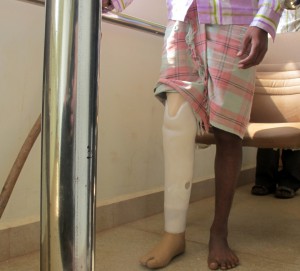Our group, Nonspec, came to the prosthetic lab first and foremost, to observe what the current process was to create a limb for a patient. We were honored to be able to observe a pivotal moment in a young man’s life – his first step on a prosthetic leg. This man, just 19 years old, was in an auto accident which resulted in the amputation of his right foot several months ago. (As an aside, 2/3 of amputees in India are men, and most of these are the result of trauma, most often road accidents). He was a mason, living with his family. However, he has been unemployed as a result of this accident. The family is poor, and cannot afford the articulating limb that would allow him to return to his profession. However, this less functional limb will allow him to walk – which is a dream when compared to using a wooden cane to ambulate. Once his prosthetic leg was finalized, it took him only seconds to rise up and walk in the gait training room with the supports of the railings. Soon, he was ambulating with just the support of a cane to stabilize him. He and his brother walked to the bus to take the several hour trip back to their home town.
I will think of this young man often – what could have been done differently, so that he could not only survive his injury, but thrive? Was the amputation necessary, or were the injuries costly to repair and the less costly amputation chosen? What if he had an articulated leg – could he be a mason again, far more productive for his family, and more readily able to support a wife and children in the future? How will his new prosthetic work – will there be pressure ulcers that form, causing pain with each step, or infection? Without training, how will he learn to navigate the rough Indian terrain without injury?
Even though it was breathtaking to see him take his first steps, I still feel we have fallen short in our care for this man.

